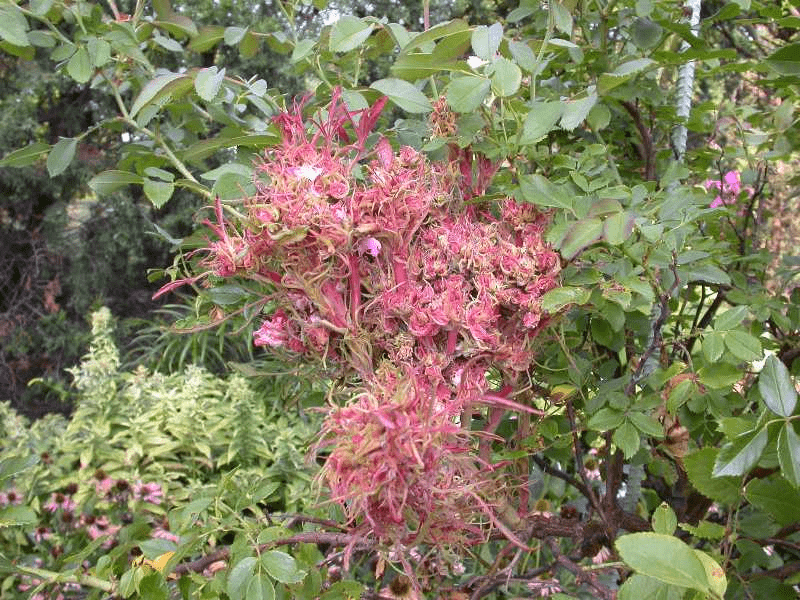Rose Rosette is a severely damaging disease to nearly all cultivated roses, especially the popular Knock-Out roses. Symptoms include leaf distortion; witches broom; abnormal red discoloration; and increased shoot elongation. Rose Rosette is caused by a virus transmitted by eriophyid mites. These mites cannot fly but do crawl or drift on air currents from one infected plant to another. This explains why large plantings of roses generally have more symptoms than landscapes with one or two roses scattered about.
Multiflora rose, the wild and invasive weed rose, is the primary host of the mite and an important source of the virus. Removing multiflora roses from within 100 yards of cultivated roses can help. To protect uninfected roses from eriophyid mites, you can treat with a bifenthrin spray every two weeks between April and September. This may prevent additional plants from becoming diseased.
If your rose is infected, there is no cure. The virus is systemic so removing a branch or two that show symptoms does not prevent it from spreading to the roots or the other branches. The plant, including the roots, must be removed completely. Do not compost; burn or throw them out to avoid spreading mites to healthy plants. Remove and destroy any regrowth that occurs from roots remaining in the soil.

As far as we know, there are no resistant (or even partial resistant) roses. The American Rose Society has just granted pathologists at University of Tennessee to pursue research regarding Rose Rosette and possible new management options or resistant cultivars. However it will be a few years before that information is available.
With the continuing outbreak of Rose Rosette disease on our favored Knock-Out roses, gardeners are left with gap, in many cases a literal gap in the garden. The question then becomes what to plant in its place. Knock-Out roses became very popular for a few reasons. They offer up to 6 weeks of bloom, they are heat and cold tolerant, disease resistant (except for Rose Rosette), and stay a manageable size around 4 feet tall. Since any rose is susceptible we need to consider other plant options.
One to consider is the Blue Mist Shrub (Caryopteris x clandonensis). It is a lovely garden shrub with fragrant leaves, stems and flowers. The leaves are short and narrow resembling a willow’s and are usually a silvery-gray. It forms feathery puffs of blue blooms from July to late August. Extremely drought and heat tolerant, virtually pest free, but plan to cut it back to about 18 inches in late winter to keep a mounded shape. Blue Mist grows to 4 feet tall. There are several cultivars to consider including ‘Dark Knight’, ‘Sunshine Blue’ which has yellow foliage, and ‘Pink Chablis’ with pink flowers.
Another great choice is the Bloomerang Lilac (Syringa x) from Proven Winners. This lilac is ideal because it is a repeat bloomer. Blooming with classic fragrant pruple flowers first in spring then, after a short rest, reblooming in midsummer right up to frost. Bloomerang stays under 5 feet tall and is breed to be mildew resistant. It needs full sun and extra water during extreme summer heat.
One of my personal favorites is the Summer Wine Ninebark (Physocarpus opulifolius ‘Seward’).
Although the bloom stage is a few weeks shorter, it more than makes up for it with its deep, wine-red foliage all season. Ninebarks tolerate drought, erosion, clay soil, dry soil, rocky soil…you name, they take it; plus no pest problems. Summer Wine typically grows 4 to 6’ tall but it can be cut back to ground each winter to control size and to rejuvenate.
Finally, ‘Hummingbird’ ‘Summersweet (Clethra alnifolia) is an excellent low-growing shrub with showy, fragrant white bloom stalks in July and August. Hummingbird tolerates full sun, heavy shade, clay soils, and even wet soils. The flowers are attractive to bees and butterflies. It is a trouble free plant with good yellow fall color.
— Kelly Jackson, Christian County Extension Office






